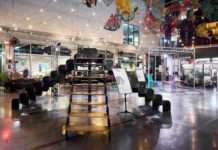Workplace hygiene has always been important, and in the age of COVID-19 the world is paying more attention to what we lay our hands on – and what we may be transporting on them. It’s been a bumper year for germicidal soaps, sprays and sanitisers, as homes and workplaces do their utmost to prevent the virus from spreading into their communities. It’s also no surprise that other, more innovative ways of disinfection – including devices that make use of ultraviolet light – are popping up more and more.
You may have seen UV light being used as a sanitiser even before the pandemic – perhaps being used to clean tools at your local salon or as part of a pricey cellphone-sanitising gadget.
You’ve also probably been told that UV rays of the type generated by the sun and tanning beds can be dangerous, damaging our DNA and prematurely ageing our skin and eyes.
So, it’s too dangerous to use on people, right?
Not at all. What’s important to remember is that not all wavelengths of UV light are created equal. The sun emits a wide range of ultraviolet wavelengths, including those we know to be damaging to our health. UVC is among these, but unlike UVA and UVB rays, UVC light is prevented from reaching the Earth by our ozone layer, which acts to filter it out.
Filtered far-UVC light, unlike regular UVC, is considered safe for humans, as its wavelengths of 222nm are too short to penetrate human skin or eyes.
If it’s so safe, how do we know it’s still effective against COVID-19?
UVC is also known as germicidal UV and includes wavelengths from 200-280nm. This form of UV sterilisation has been in use for decades in applications such as water treatment and surface disinfection. The great news is that filtered far-UVC falls into this spectrum and is therefore both extremely effective against pathogens and harmless to humans. Research released by the US Food & Drug Administration* suggests that filtered far-UVC effectively destroys the outer protein of airborne coronaviruses without the same risk of skin damage that typical UV light poses.
Surely there are other side-effects of being under filtered far-UVC light for extended periods?
Though it’s often associated with a trademark purple glow, UV light, including filtered far-UVC, is invisible to the human eye, and won’t bother employees in the workplace. As we’ve already mentioned, this wavelength cannot penetrate further than the very outer surface of the skin and eyes, with extensive testing proving it safe for regular use in sanitising a wide variety of traffic-heavy locations.
It’s probably expensive to run, right?
Not at all! Generating filtered far-UVC light is essentially very similar to how any other fluorescent bulbs work and are equally economical. Fluorescent bulbs produce less heat than incandescent bulbs and are therefore much more energy efficient – up to six times more efficient, in fact**.
Is it safe for animals?
Absolutely! This technology has been confirmed as harmless to animals and is even being used to control the spread of COVID-19 in hygiene-intensive animal environments like vets, pet daycare facilities and more.
The bottom Line
No matter how carefully we may sanitise our hands or clean our surfaces, the new normal we all face as a civilisation is going to require some serious innovation to make many of our public spaces safe again – not only from COVID-19, but influenza, airborne fungi, and other pathogens we encounter on a daily basis. In places where constant spritzing and spraying are simply not possible, filtered far-UVC sanitising light technology is showing amazing promise as a highly effective and non-invasive alternative that may help us get back to normal much sooner.












